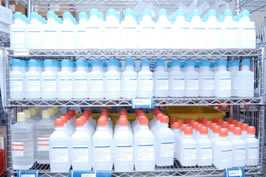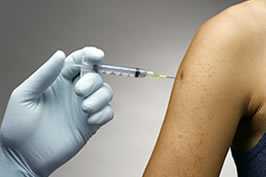Countermeasure Tracking Systems consists of multiple interoperating components that enhance the capacity of federal, state, and local public health agencies to track and manage medical and non-medical inventory and usage to support both daily operations and all-hazards events.
CTS Background
 The Centers for Disease Control and Prevention (CDC) works to protect and keep our nation safe during all-hazards events (e.g., pandemic influenza, terrorist attack) through the distribution and tracking of medicine and other medical or non-medical supplies, also referred to as countermeasures. In an effort to support these processes, CDC established the Countermeasure Tracking Systems (CTS) program.
The Centers for Disease Control and Prevention (CDC) works to protect and keep our nation safe during all-hazards events (e.g., pandemic influenza, terrorist attack) through the distribution and tracking of medicine and other medical or non-medical supplies, also referred to as countermeasures. In an effort to support these processes, CDC established the Countermeasure Tracking Systems (CTS) program.
During a public health emergency, there is a need to understand the distribution and usage of countermeasures, both in aggregate and at the individual level. This information guides decisions for further deployment and distribution of countermeasures during an event and can provide for future follow up, reference and safety in the event of a recall. Critical to the success of this program is the leverage of state and local partners’ existing information systems by supporting standard information exchange with immunization information systems (IIS), inventory tracking systems and other relevant systems. During the 2009 H1N1 Vaccination Campaign, CDC used multiple CTS components to assess countermeasure availability and coverage of target populations. This is another example of CDC working 24/7 to save lives and protect people.
CTS Overview
CTS consists of multiple interoperating components which enhance the capacity of federal, state, and local public health agencies to track and manage medical and non-medical inventory and usage to support both daily operations and all-hazards events. The systems interoperate to improve communications and event response efficiency while still functioning independently, recognizing the unique requirements and use cases for each system. In support of close communication and linkage among the components, all CTS components have a similar “look and feel” and use the same security mechanism which allows a seamless transition between systems, enhancing ease of use and supporting just-in-time training. Collectively, the data consolidated from these systems can show population coverage, numbers of untreated individuals, drug and equipment shortages, need for resupply and more. The Web-based applications are deployed centrally at CDC and use the CDC’s secure data access method for security. They are available free of charge to users.
Overview of System Components
IMATS
The Inventory Management and Tracking System (IMATS) solution provides state and local public health providers with a tool to track medical and non-medical countermeasure inventory and supplies during daily operations or an event. The solution tracks quantities of inventory, monitors reorder thresholds, and facilitates warehouse operations including receiving, staging, and storing of inventory.
CRA
The Countermeasure and Response Administration System (CRA) is an emergency preparedness and response asset useful for any event involving vaccine doses administered tracking, pharmaceuticals and medical material dispensing, or implementation of social distancing measures. CRA supports analysis of pharmaceutical safety, coverage, and effectiveness during an event which improves patient outcomes. CRA is a flexible all-hazards system that reduces the need for development of new applications each time there is a new event.
CIT
The Countermeasure Inventory Tracking (CIT) Dashboard (a.k.a. the Countermeasure Supply Chain Dashboard) is a situational awareness tool used by the Division of Strategic National Stockpile to construct a nationwide inventory supply picture. The CIT Dashboard consolidates project area inventory data reported through CRA with data from the commercial drug sector. This consolidated data forms a complete inventory supply picture which provides situational awareness during an event.
- Page last reviewed: October 31, 2016
- Page last updated: October 1, 2015
- Content source:


 ShareCompartir
ShareCompartir





